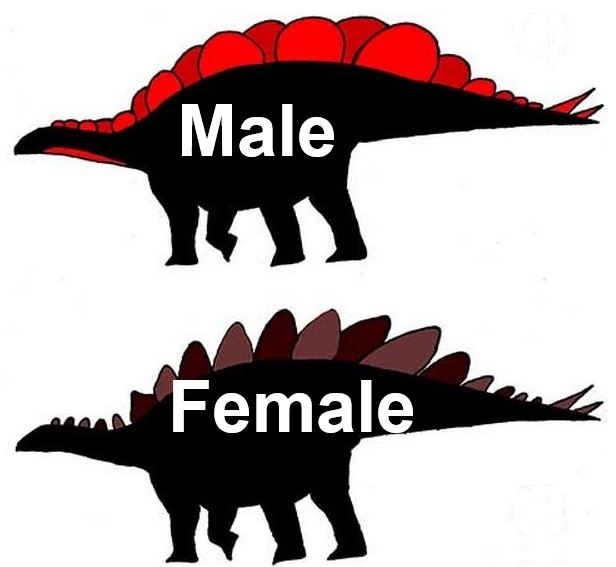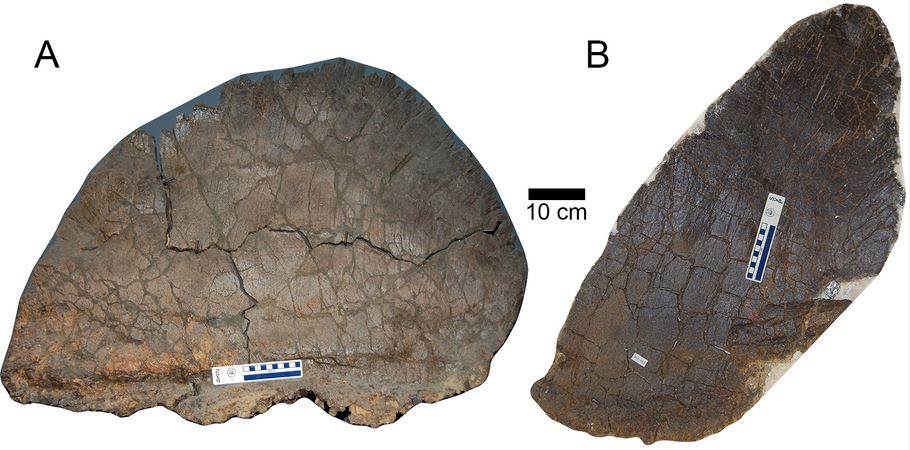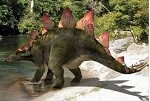You can tell a male Stegosaurus from a female by the two staggered rows of bony plates along their backs – they are different, says University of Bristol MSc student Evan Thomas Saitta. He believes the males had the larger, wide plates, while the females had the taller, thinner ones, but he cannot be 100% sure.
Saitta explained in the open-access journal PLOS ONE that some Stegosaurus specimens he studied had wide plates, while other had tall plates. The wide-plated ones had plates that were 45% larger overall.
Speculating which is male and which is female, Saitta said:
“As males typically invest more in their ornamentation, the larger, wide plates likely came from males. These broad plates would have provided a great display surface to attract mates. The tall plates might have functioned as prickly predator deterrents in females.”

Two hypothetical images of the male and female Stegosaurus. (Credit: Evan Saitta)
“These stegosaurs seem to provide the first really convincing evidence for sexual dimorphism in a dinosaur species (excluding birds, which are technically dinosaurs themselves).”
Dimorphism is common
Anatomical differences between males and females of the same species (dimorphism) is very common among animals today. However, it is surprisingly difficult to determine in species that have become extinct, especially dinosaurs.
Stegosaurus was a large, plant-eating dinosaur that existed bout 150 million years ago. It had two staggered rows of bony plates along its back.
Saitta examined a group of Stegosaurus mjosi with varied plates. They had been excavated in central Montana’s Stegosaurus ‘graveyard. He also studied previously excavated Stegosaurus mjosi specimens.
He found that the wide-plated and tall-plated Stegosauruses were not two different species, nor were they individuals of different age – they were, in fact, males and females.

(A) The largest wide morph plate. (B) The largest tall morph plate. (Image: PLOS ONE)
Microscope analysis and CT scanning showed that the plates in both varieties had stopped growing, so the differences could not have been a result of different ages.
The presence of sexual dimorphism in an extinct species may provide researchers with a much clearer picture of Stegosaurus behaviour than would otherwise be possible, Saitta wrote.
Saitta concluded in an Abstract in the journal:
“Dinosaur ornamentation possibly served similar functions to the ornamentation of modern species. Comparisons to ornamentation involved in sexual selection of extant species, such as the horns of bovids, may be appropriate in predicting the function of some dinosaur ornamentation.”
Citation: “Evidence for Sexual Dimorphism in the Plated Dinosaur Stegosaurus mjosi (Ornithischia, Stegosauria) from the Morrison Formation (Upper Jurassic) of Western USA,” Evan Thomas Saitta. PLOS ONE. Published 22 April, 2015. DOI: 10.1371/journal.pone.0123503.
BBC Video – Stegosaurus
In this BBC video, you can see how a Stegosaurus may have defended itself against predators by swinging its spiky tail.

